
Gilbert Laird Jessop was an English cricket player, often reckoned to have been the fastest run-scorer cricket has ever known. He was Wisden Cricketer of the Year for 1898.

Hedley Verity was a professional cricketer who played for Yorkshire and England between 1930 and 1939. A slow left-arm orthodox bowler, he took 1,956 wickets in first-class cricket at an average of 14.90 and 144 wickets in 40 Tests at an average of 24.37.
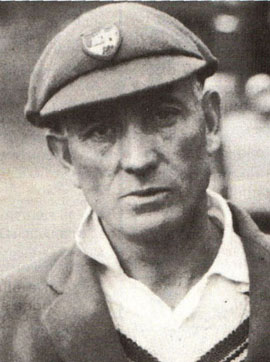
Charles Warrington Leonard Parker was an English cricketer, who stands as the third highest wicket taker in the history of first-class cricket, behind Wilfred Rhodes and Tich Freeman.

Arthur Webb Mold was an English professional cricketer who played first-class cricket for Lancashire as a fast bowler between 1889 and 1901. A Wisden Cricketer of the Year in 1892, he was selected for England in three Test matches in 1893. Mold was one of the most effective bowlers in England during the 1890s but his career was overshadowed by controversy over his bowling action. Although he took 1,673 wickets in first-class matches, many commentators viewed his achievements as tainted.

Tom Richardson was an English cricketer. A fast bowler, Richardson relied to a great extent on the break-back, a relatively long run-up and high arm which allowed him to gain sharp lift on fast pitches even from the full, straight length he always bowled. He played 358 first-class cricket matches including 14 Tests, taking a total of 2,104 wickets. In the four consecutive seasons from 1894 to 1897 he took 1,005 wickets, a figure surpassed over such a period only by the slow bowler Tich Freeman. He took 290 wickets in 1895, again a figure only exceeded by Freeman (twice). In 1963 Neville Cardus selected him as one of his "Six Giants of the Wisden Century".

Wilfred Rhodes was an English professional cricketer who played 58 Test matches for England between 1899 and 1930. In Tests, Rhodes took 127 wickets and scored 2,325 runs, becoming the first Englishman to complete the double of 1,000 runs and 100 wickets in Test matches. He holds the world records both for the most appearances made in first-class cricket, and for the most wickets taken (4,204). He completed the double of 1,000 runs and 100 wickets in an English cricket season a record 16 times. Rhodes played for Yorkshire and England into his fifties, and in his final Test in 1930 was, at 52 years and 165 days, the oldest player who has appeared in a Test match.
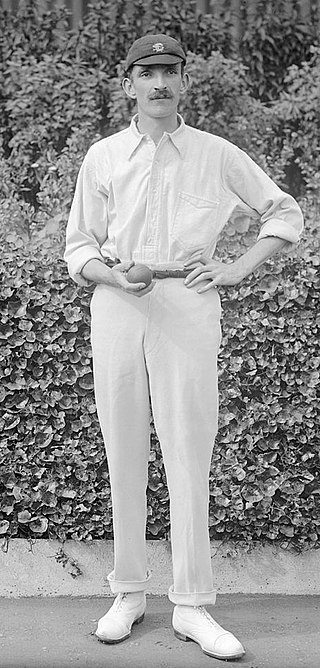
William Charles "Razor" Smith was a Surrey slow bowler. Nicknamed "Razor" because of his extreme thinness, Smith was a frail man and prone to serious injury; he could rarely get through a full season's cricket, but when fit and healthy, could command the sharpest off-break among bowlers of his day. He was also able to bowl a somewhat faster ball with a very high flight that turned a little from leg and, with any help from the pitch, would get up almost straight.
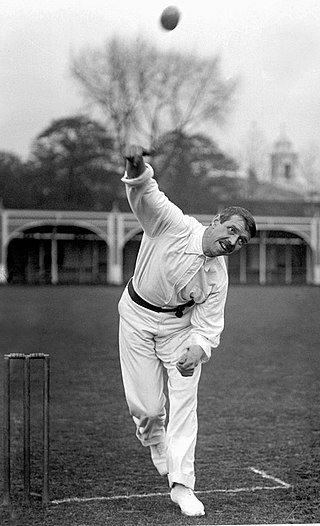
Albert William Hallam was an English off spin bowler who is primarily remembered, along with Thomas Wass, for giving Nottinghamshire an astonishing win in the County Championship of 1907. They did not lose a single match and managed to win fifteen out of nineteen games in which a ball was actually bowled. This is the highest proportion of wins by an undefeated side and the third highest proportion of wins in County Championship history – and the two higher figures were in very dry summers with almost no rain interruptions.
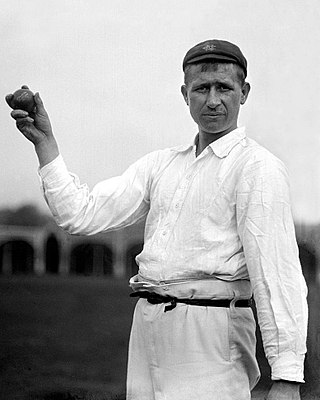
Thomas George Wass was a Nottinghamshire bowler who is best remembered, along with Albert Hallam, for bowling that gave Nottinghamshire a brilliant County Championship win in 1907. Wass also holds the record for the most wickets taken for Nottinghamshire - 1633 for 20.34 each.
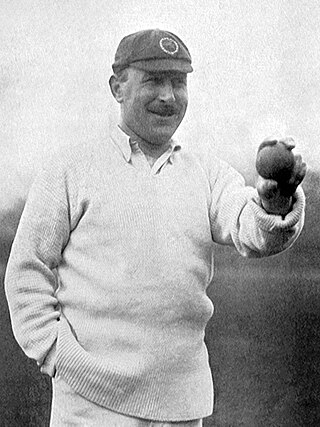
George Herbert Hirst was a professional English cricketer who played first-class cricket for Yorkshire County Cricket Club between 1891 and 1921, with a further appearance in 1929. One of the best all-rounders of his time, Hirst was a left arm medium-fast bowler and right-handed batsman. He played in 24 Test matches for England between 1897 and 1909, touring Australia twice. He completed the double of 1,000 runs and 100 wickets in an English cricket season 14 times, the second most of any cricketer after his contemporary and team-mate Wilfred Rhodes. One of the Wisden Cricketers of the Year for 1901, Hirst scored 36,356 runs and took 2,742 wickets in first-class cricket. In Tests, he made 790 runs and captured 59 wickets.
Walter Scott Lees was a Surrey and England cricketer who played in five Test matches against South Africa in 1906. On his debut, he took five wickets in the first innings in Johannesburg.

Neville Alexander Knox was an English fast bowler of the late 1900s and effectively the successor to Tom Richardson and William Lockwood in the Surrey team. Because of his profession as a singer, Knox's cricket career was short, but he was undoubtedly the fastest bowler of his time and one of the fastest bowlers ever to play for England — probably capable of speeds over 150 km/h (93 mph).

Abraham "Abe" Waddington, sometimes known as Abram Waddington, was a professional cricketer for Yorkshire, who played in two Test matches for England, both against Australia in 1920–21. Between 1919 and 1927 Waddington made 255 appearances for Yorkshire, and in all first-class cricket played 266 matches. In these games, he took a total of 852 wickets with his left arm fast-medium bowling. Capable of making the ball swing, Waddington was admired for the aesthetic quality of his bowling action. He was a hostile bowler who sometimes sledged opposing batsmen and questioned umpires' decisions, behaviour which was unusual during his playing days.
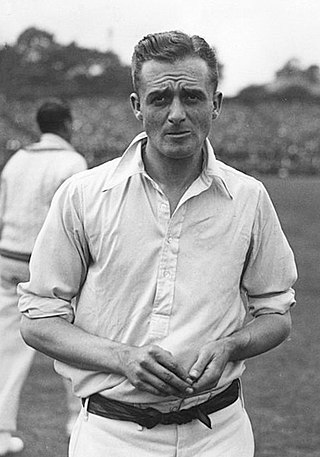
George Gibson Macaulay was a professional English cricketer who played first-class cricket for Yorkshire County Cricket Club between 1920 and 1935. He played in eight Test matches for England from 1923 to 1933, achieving the rare feat of taking a wicket with his first ball in Test cricket. One of the five Wisden Cricketers of the Year in 1924, he took 1,838 first-class wickets at an average of 17.64 including four hat-tricks.

Thomas Bignall Mitchell was an English first-class cricketer who played for Derbyshire between 1928 and 1939.

Holcombe Douglas "Hopper" Read was an English cricketer who played in one Test in 1935.
1906 was the 17th season of County Championship cricket in England. The title was decided in the final round of matches with Kent County Cricket Club finishing just ahead of Yorkshire. George Hirst completed a unique "double Double" of 2,385 runs and 208 wickets. Tom Hayward broke Bobby Abel’s 1901 record for the most runs scored in a first-class season.
1907 was the 18th season of County Championship cricket in England. Nottinghamshire won their first official title. England played their sixth Test series against South Africa but it was the first to be held in England.
1876 was the 90th season of cricket in England since the foundation of Marylebone Cricket Club (MCC). Gloucestershire reclaimed the unofficial "Champion County" title. A relatively dry summer and improvements to pitches via the heavy roller saw several batting records broken.

Sam Hargreave was the most successful bowler for Warwickshire until the success of Foster and Field in winning the 1911 County Championship.
















